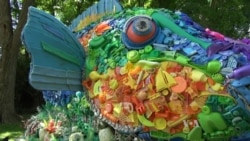A giant parrot fish greets visitors at the main entrance to the National Zoo in Washington, D.C. A bit farther on are a tufted puffin seabird, a freedom starfish and more — all bright, beautiful and eye-catching sculptures.
But if you take a closer look, you notice they are assembled with plastic toys, a hair comb, bottle caps, beer cans and many other everyday objects.
"I observed visitors coming in, thinking these sculptures are made out of recycled plastic. But, in fact, they are marine debris. And when they find out, they are shocked," said Maria Amaya, a volunteer at the National Zoo.
The National Zoo is home to about 1,800 animals, representing 300 species. But throughout the summer, visitors can see new, captivating creatures as part of the special exhibit, Washed Ashore: Art to Save the Sea. The larger-than-life animal sculptures speak volumes about the global issue of massive plastic pollution in the oceans.
The sculptures were created by Angela Haseltine Pozzi — with the help of thousands of volunteers — to deliver a serious message.
"This is all plastic picked up off of beaches, every single bit of it," said Pozzi, executive director of Washed Ashore, a non-profit environmental group. "So we have processed about 18 tons of garbage off of a small area of beach in the last six years. And it could be anywhere in the world. This is a worldwide problem, the plastic pollution issue."
Pozzi has created 68 such sculptures, and 17 of them are displayed throughout the National Zoo. The whale bone ribcage on display is made entirely of bleach bottles; the blue marlin has flip-flops inside its mouth; and hundreds of water bottles create the jellyfish.
"I've purposely chosen to represent the animals that are threatened by marine debris,” Pozzi said. “The fact that plastic breaks down into microscopic pieces and is getting into the entire food chain means that everything in the ocean is affected by it."
A recent study estimates that about eight million tons of plastic waste enters the oceans each year, posing a threat to a wide variety of marine animals.
"Single-use plastics are probably the worst you can get,” Pozzi said. “They are used for five seconds and then last forever. We don't even think about it."
The artwork seems to be making an impact on visitors of all ages.
"First we need to make sure that no trash is washed up," said third-grader Ava Teleki, on a school field trip. "So instead of leaving it onto the beach, you need to pick it up and you need to put in the trash [can] before it gets washed out and gets [eaten by] fish. Or you can recycle it."
Diana Rodriguez visited the zoo with a friend. "We have to be more careful,” she said. “We have to be more attentive about what we do with the containers and things we use."
Pozzi hopes her traveling exhibit will reach as many people as possible across the United States, and overseas as well.













